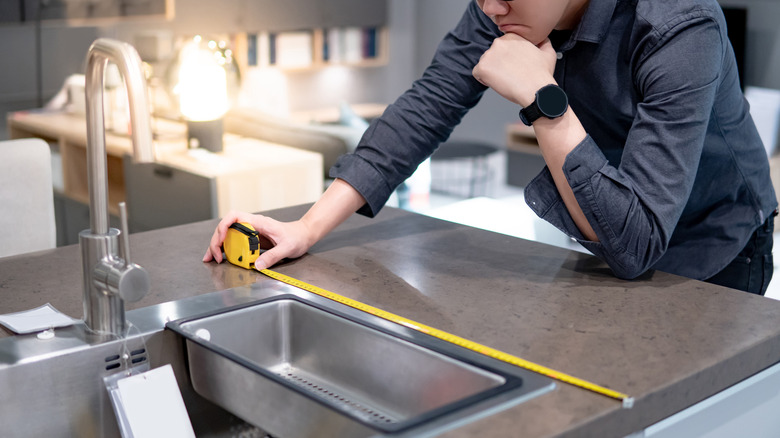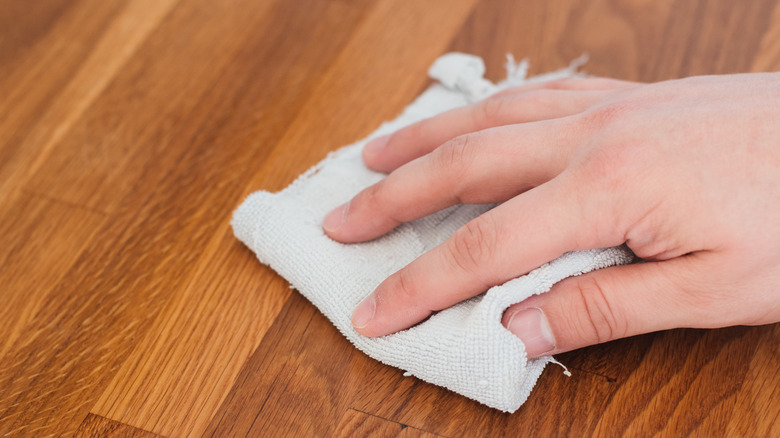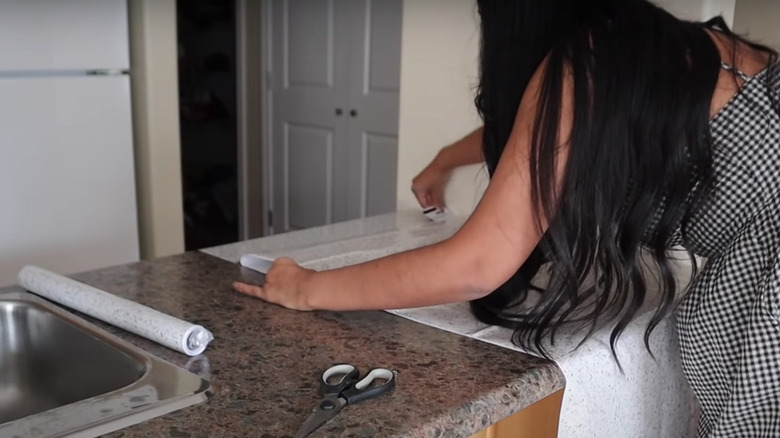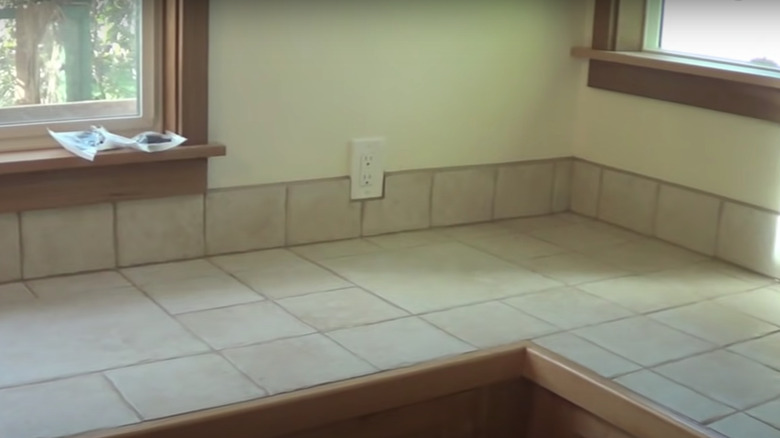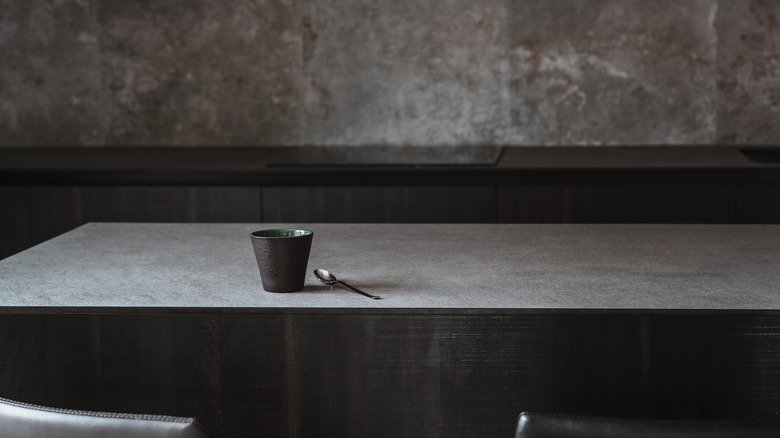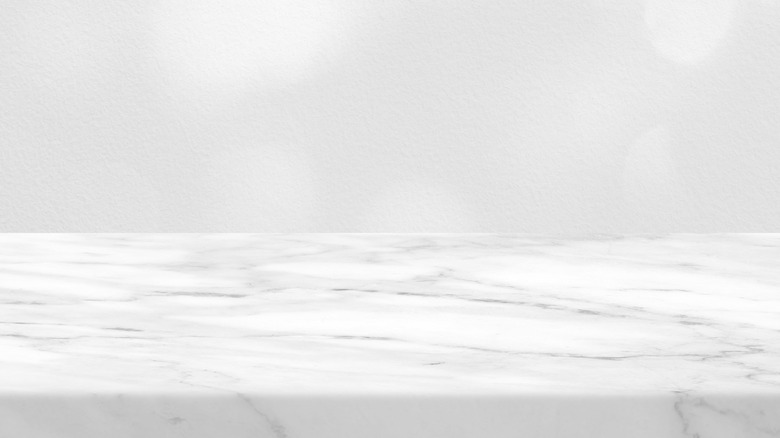5 Ways To Make Laminate Countertops Work For Your Kitchen
Countertops can either elevate or deflate the overall design of a space if it isn't up to par with the rest of the room. You could have a lovely wall color, a beautiful backsplash, and fantastic floor tiles — but if your countertop doesn't match that same energy and flow, it'll prevent the stunning, harmonious look you've been trying to achieve. Currently, only 16% of new homes have laminate countertops, as they are the least popular, per the National Association of Home Builders. Most others, nowadays, have either granite countertops or some engineered stone. If you're some of the unlucky few who ended up with laminate countertops, there are ways to create a new and fresh look without a large budget.
We've come up with a few to turn your laminate countertops from drab to fab. These tactics will most likely help you accomplish whatever look you're going for, whether modern or contemporary. Most of the tools are fairly affordable and easy to find, and you don't have to be a residential construction expert to execute these projects successfully.
1. New painting project
Luckily, there's a way homeowners can avoid spending thousands of dollars, as well as the hassle of having construction workers in their home, all thanks to a simple bucket of paint and other tools you probably already have, per This Old House. You'll first need to give your laminate countertops some texture for the primer and paint to stick to, so you'll have to use medium-grit sandpaper. Once sanded and wiped down, lay down painter's tape in areas around the sink and cabinets.
You'll then use a foam roller to apply primer smoothly and evenly across the countertop and switch to a brush for corners and edges. Once the primer is completely dry, you can grab a new paint roller and your paint color of choice and start rolling that onto the countertop the same way you did the primer — you will most likely need to apply a second coat. Lastly, make sure you protect your entire painting project with a top coat, which will save your work from any water damage.
2. Contact paper
Depending on how much countertop space you're working with, you could spend a max of $25, per Building Bluebird. As this person worked on remodeling their laundry room, they were able to transform the mint green appearance of their laminate countertop to a black, wood texture visual. Only a few tools were needed: contact paper, scissors, an Exacto knife, and a heat gun. If your countertop has a short backsplash, that is where you will start.
You'll begin by measuring the entire length of the backsplash, but add a few inches in case of mistakes. The back of the paper should have lines, so follow those when you start cutting. There will also be a backing that you'll need to pull off before sticking the paper onto your countertop; you'll continue to remove it as you move down the surface, ensuring you're pushing out any air bubbles you see. You'll do edges first before the flat surface, using the Exacto knife to cut away any extra pieces. Once done, you'll use the heat gun all over to seal in the contact paper and get rid of any pesky air bubbles you couldn't remove.
3. Tile
Tiling your countertop may seem like it'll turn into this crazy look, but it can appear soft and straightforward as long as you use solid colors. Undertaking this project is very doable, and the most important thing you'll need besides the tile is a quarter-inch backboard, per Fine Homebuilding. The backboard would first need to be screwed into the laminate countertop to provide a solid backing for installing tile onto — which will save you hundreds of dollars. Installing tile directly onto a laminate countertop is not feasible, as the adhesives will not stick securely.
However, you must ensure your countertop is strong enough for this project and hasn't been too damaged by water and heat elements. You can usually tell if the laminate is too weak if you can dig into it with a screwdriver or if you see that it's a bit bloated from water exposure.
4. Concrete
If you love the industrial look but are currently stuck with laminate countertops, you'll be happy to know that you can create your own concrete countertops, per A Beautiful Mess. Just like when you paint, you'll have to start off by sanding the surface of your countertop to create a gritty texture, wipe up your mess, then apply painter's tape above the lip in the area between the wall tiles. You'll use putty knives to start mixing a one-to-two ratio with one part water to two parts dry cement and mix it into whatever disposable cup or bucket you have. It's advised to use small amounts at a time, so you can spread it all before it dries out.
As you swipe the concrete mixture on the countertop, ensure you start from the back and pull it towards yourself. You'll have to swipe in different directions when working with corners for a smooth look. If you've accidentally put on too much concrete, you can always sand off the excess when it dries. After the first coat dries over 24 hours, you can do another layer and smooth it for a few hours until you get the look you desire.
5. Marble effect
Who are we kidding? The demand for marble countertops continues to be high, and manufacturers aren't able to mine them fast enough, per CounterTop Guides. You don't have to have the proper funds for new marble countertops, as you can make them yourself. If you've already followed the steps introduced earlier on how to paint your countertop, then you've already done most of the work to create the base. Now, it's time to create the desired marble look of your dreams with simple tools.
Marble is a natural stone, meaning the design will flow differently throughout. To create a unique variation, you'll grab a round brush cover and put it in gray paint before circling it onto specific parts of the surface. A sponge will be used next to dab the paint until it is a dull, grain look typically seen in the stone. Surprisingly, a feather is a perfect tool to create the marble veining. Tip the end into the paint and softly drag it across the countertop in different directions. You'll add a bit more gray color and blend it in to blur out the lines for a more realistic look.
